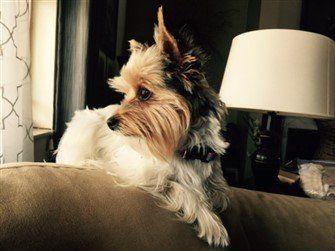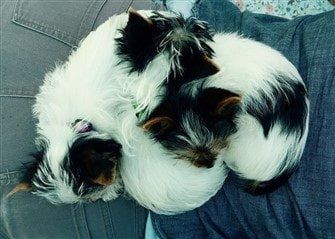Biewer
The Biewer Yorkshire Terrier
What is a Biewer Yorkie?
Many wonder if a Biewer Yorkshire Terrier is the same dog as a Yorkshire Terrier…Or is this a separate dog breed?
The official name of the breed is Biewer Terrier, the 'Yorkshire' part is not technically part of it.
The answer is that while there are a lot of similarities…and the Biewer was developed from Yorkies, they are as of now, a separate breed. Not only this, but he is considered to be a very rare breed (as not many of these dog exist in comparison to other breeds).
Technically, a Biewer Yorkshire Terrier is a Yorkie that has specific coloring…and due to the breeding
processes that have taken place, the dog has subtle features that give him his own appearance.
The coloring
of the dog is tri-colored….often referred to as banded or belted. This one element is the main one that sets the Biewer apart, thus making him a separate dog breed.


Image by By Nataly F. (Own work) via Wikimedia Commons
The main differences between a Yorkshire Terrier and a Biewer Yorkshire Terrier are:
• Coat color – Yorkies technically have only 2 colors (either tan or gold and black or blue); Biewer Terriers all have 3 colors which include white and those fall on specific areas of the body. So, if you see a dog that looks just like a Yorkie but has white hair, you're probably seeing a Biewer.
• The tail is traditionally NOT docked, since this breed is most popular in Europe where docking is not legal.
Similarities
Aside from the very obvious appearance similarities aside from coloring, both dogs:
• Are considered to be hypo-allergenic
• Light shedders– as the loose hairs tend to fall into the coat rather than out and on the ground as with other breeds with have fur (particularly those breeds with 2 coats – outer and under coat)
• The texture of the coat
• Are small toy sized, indoor dogs
• Tend to have the same personality traits, although the Yorkshire Terrier was first bred to be a hunter and the Biewer bred to be a companion dog.
• Life expectancy is the same: 12 to 15 years


Maggie, photo courtesy of Tracy Wiesenberg
The Biewer's Road to AKC Acceptance
It took some time for the Biewer to be accepted.
The very first Biewer was born from two Yorkshire Terriers in 1984. Due to the unique coloring and appearance, this one dog was the start of the breed. Though at the time, no one knew where this would lead.
In fact, he was given his name (pronounced bee-vare) from the last name of the couple that produced that first puppy in 1984, Werner and Gertrud Biewer.
Biewer clubs quickly popped up, with breeders very excited about this possible new dog breed. At that time, the most well known clubs that pushed for acceptance were:
• Biewer Terrier Registry of America - BTRA who call the breed "Biewer Terrier"
• The Biewer Breed International Registry - BBIR who call the breed "Biewer"
• The Biewer National Registry - BNR who call the breed "Biewer a la Pom Pon"
• BYA - Biewer Yorkie Association
Since this was a new breed and no one knew what was to come, the Biewer Yorkshire Terrier was also part of:
• Rarities INc & NAKC – A conformation show organization
• The American Rare Breed Association
• The IABCS – A conformation show organization
• The Rare Breed Network
• The National Canine Association
In 2009, the Biewer breed signature was created by Mars Veterinary. The breed standard was then drawn up based on scientific data as opposed to data derived from pedigrees, which makes this a very unique situation.
It was not until 2014 that the Biewer was added to the AKC's Foundation Stock Service.
How the Biewer Was Developed
This breed was developed in Germany, with the very first puppy being born in 1984. And not long afterward, was officially recognized in 1986 by the "ACH" - Allgemeiner Club der Hundefreunde Deutschland (Germany).
The element that caused this breed to be perfected into its own class was the fact that German registrations did not accept the tri-colored Yorkie as part of the standard coloring for the dog.
Note: The AKC DOES accept a tri-colored Yorkie…however the Biewer has taken on other qualities and conformation elements that now set him aside from the Yorkshire Terrier standard.
Now to clarify, the AKC accepts Yorkies of 3 colors, even though the color list only shows:


3 Sleeping Beauties
Photo courtesy of Tracy Wiesenberg


Rayna (mother) and Maggie (daughter)
Photo courtesy of Tracy Wiesenberg
Black & Gold
Black & Tan
Blue & Gold
Blue & Tan
This is because many of these parti (2 color) dogs have an additional 3rd color as a “marking”
When a new registry was formed in Europe, the dog was given the name of Biewer Yorkshire Terrier A la Pom Pon… often now shortened to just “Biewer Yorkie” or “A la Pom Pon”.
If the tri-colored dog was allowed into the breed standard, the Biewer would not exist today. It is amazing how a simple element as this can produce a new breed!
While there are some theories that different breeds may have been used in developing this breed, one thing is very clear: The Yorkshire Terrier is strong in the bloodlines.
The main person who is credited with this off-shoot of the Yorkie also was known for breeding Shih Tzu
dogs…And because of this, many jump to the conclusion that Tzu were mixed into the bloodlines along the line. Many disagree with this theory, as the coloring would be off….With a Shih Tzu brought in, that 1st generation puppy (the offspring) would not be tri-banded (colored) unless the Yorkie also happened to carry the genes for that…and the chances are slim.
However, with this being said, the coat of the Biewer is softer, more akin to that of a Shih Tzu…and this does bring one to think about the possibility.
Another theory is that the pure white Maltese plays a role in the development of the Biewer.
The only way to put theories to rest would be to DNA test the first original Biewer Yorkshire Terrier….and it is too late for this to be done.
According to records (and in contrast to the above mentioned theories), the 2 Yorkies that are credited with producing the Biewer are a female named Darling von Friedheck and Fru-Fur von Friedheck, both champions in Europe.
Some speculate that the offspring of these 2 dogs was actually a genetic mutation, however this is strongly thought to be false. You see, mutations are rare occurrences….and after the mating of Darling and Fru-Fru, more litters were produced….And those puppies all held true to the new standard of the Biewer.
The Biewer Yorkshire Terrier is indeed produced by the pairing of 2 Yorkies that BOTH have recessive piebald genes….when passed onto the newborns, it forms the tri-colored (banded/ belted) appearance.


Rayna; Photo courtesy of Tracy Wiesenberg
Owner Information
Many owners wonder if their Biewer Yorkshire Terrier should be registered when purchased…
The answer depends on where you obtain the puppy from. If the pup comes directly from the country of Germany, he or she should be registered by a dog club in Germany. You should be given both the dog’s registration and his or her pedigree before obtaining him.
There are rumors that the IBC in Germany is the only recognized club and that if the pup is not registered with them, the dog holds less value. This is not true.
Now, if you obtain the puppy from a breeder in the United States, he or she should be registered by one of the above mentioned registries. It is highly suggested to be given the registration and pedigree before finalizing the purchase.
The one element to keep in mind is that a legitimate breeder will have proof of both the sire(father) and dam (mother) of the puppy.
We do suggest registering your Biewer Yorkshire Terrier. Why? Because the breeding pairing will be kept on record and the dog will be able to be tracked.
As time goes by, generations are recorded. This is called the pedigree and will contain very valuable information regarding the dog’s ancestors. This may one day lead to this breed being accepted by the AKC…
And it certainly increases the validity of the breed…And helps to keep track of the bloodlines, thus increasing the odds that breeders will focus on the betterment of the breed….One of the hallmarks of quality dogs.
Buyer Beware
When a breed is classified as a “rare breed” there will always be backyard breeders who think about quick profit. For this reason, some will pair 2 Yorkies together and simply call them Biewers… Others will believe the theories mentioned above and pair a Yorkie with a Shih Tzu or a Maltese and call them Biewer puppies. Quick, unplanned and thoughtless mating produces low quality dogs.
In addition, a Yorkie bred to a Biewer is not
a true, purebred Biewer Yorkshire Terrier….only 2 purebreds can produce true Biewer puppies.
The color of the dog will alert you to the fact of whether he or she is a true Biewer… color is banded hairs (strong panels of color across the body).
The Standard in Comparison to Yorkshire Terriers
This standard is extremely similar for weight. Since the weight of the Biewer Terrier was written in Europe, the metric system was used. Therefore, it gives a weight of under 3.1 kg (6.83 pounds). If it were first written in the US, it would be the same as the Yorkshire Terrier of under 7 pounds (3.17 kg).
The standard for the height is any height up to 8.66 inches (22 cm)…as opposed the AKC not having a specific height for the Yorkie, although most fall between 6-9 inches (15.24 – 22.86 cm) .
Appearance –
Coloring of the body and head are: white, blue/white, blue or black (with no brown coloring). It is customary for the head to consist of 3 colors… for the legs, belly and tail to be white. Hair on the chest should be solid white. White, blue or gold should be on the head.
The coat should be to a length of ¾ down the body or just touching the floor. The standard calls out for straight hair. The coat has only 1 layer (no undercoat).
Eyes, eye rims and nostrils should be dark.
Ears
should be small and erect.
Teeth
are either a scissor bite or a level bite
Pricing
This is a rare breed and the prices reflect that. For a purebred, the average price in the United States is between $1500 and $2500.
Reader Q&A
Question:
Let’s say we have a Biewer and a Yorkie that both weigh 3.5 pounds. Someone told me the Biewer will be bigger even though it weighs the same because its body has a different structure of length and wideness.
I don’t understand this because from what I’ve learned, they’re both Yorkies.
Is it true that the same weight Biewer will be bigger in size than the Yorkie? I ask this because my deceased 3.5 pound yorkie slept beside my head, and I’m considering getting a Biewer of the same size and want it to sleep in the same location. I was also told that Biewers tend to weigh more than Yorkies overall. Is that true?
Answer:
There is no difference at all, other than color.
It is very possible that the person who told you this happened to see a big boned Biewer, perhaps next to a small boned Yorkie. And of course, each dog is an individual; a Biewer can be bigger than a Yorkie, and vice-versa.
Please keep in mind that no breeder can guarantee adult size. So, it would be hard to have two dogs (Yorkie and Biewer) that weighed exactly the same.
But, if hypothetically, you had two 3.5 lb. dogs, they would be extremely similar in body structure, as long as both were quality dogs that fit the AKC breed standard.
All content is protected by US and International copyright laws. All rights reserved.
We are a participant in the Amazon Services LLC Associates Program, an affiliate advertising program designed to provide a means for us to earn fees by linking to Amazon.com and affiliated sites. As an Amazon Associate, we earn from qualifying purchases.
